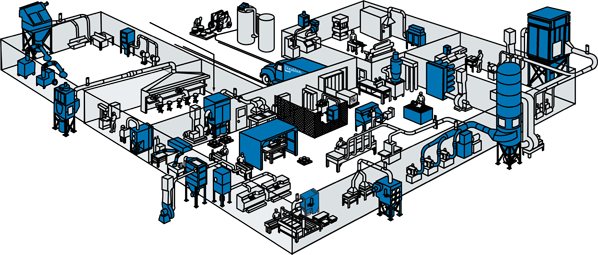Dispatch function in production management executes planning function. It is concerned with getting the work started. Dispatching ensures that the plans are properly implemented. Dispatching is the physical handing over of a manufacturing order to the operating facility (a worker) through the release of orders and instructions in accordance with a previously developed plan of activity (time and sequence) established by the scheduling section of the production planning and control department. Dispatcher transmits orders to the various shops. Dispatch function determines, by whom the job shall be done and it co-ordinates production. It is the key point of a production communications system.… Read the rest
Production Management Concepts
Tool Control in Production Management
Tool control in production management implies (1) determining tool requirements (2) procuring necessary tools and (3) controlling/maintaining tools once they have been procured. A tool or process planner must calculate tool requirements prior to the time of production to ensure that proper tools will be available when needed. Lost time resulting from incomplete tools planning can be expensive as well as causing work to delay. In order to facilitate tool control and to limit the investment in tool inventory, it is important to standardize wherever possible all the tools within an organisation.
Need for Tool ControlIt is very important to ensure:
- Against loss through theft or negligence and production delays through misplacement or non-availability of tools.
Routing in Production Management
Routing lays down the flow of work in the plant. It determines what work is to be done and where and how it will be done. Taking from raw material to the finished product, routing decides the path and sequence of operations to be performed on the job from one machine to another. The purpose of Routing is to establish the optimum sequence of operations. Routing in production management is related to considerations of layout, temporary storage of in-process inventory and material handling.
Routing in continuous industries does not present any problem because of the product type of layout, where the equipment is laid as per the sequence of operations required to be performed on the components (from raw material to the finished products).… Read the rest
Meaning of Reliability and Maintainability
Reliability may be defined as the probability, or degree of confidence that a product will perform a specified number of times under prescribed conditions. For example, the reliability of an electrical changeover switch may be defined as 0.9999. This may hold true only when it is operated with an input voltage of 440 volts AC, in an environmental temperature range of 0 to 80 degrees C, with humidity less than 90 percent, if its housing has never been opened, if it has been operated less than 1 million times, and if its is less than five years old. Even if any one of these conditions is violated, then the reliability concepts goes off.… Read the rest
Inventory Management
What is inventory? What are its varieties? Inventory is the buffer between two related sequential activities. Between purchase and production, between the beginning and completion of production, and between production and marketing, buffers are needed. Buffer means a cushion to fall back on. Production should not suffer due to some difficulty in purchase of raw materials. Marketing should not suffer due to some difficulty in production. If the business has some stock of raw materials, a temporary difficulty in purchase will not effect production since the stock of raw materials can be used. If there is a stock of finished goods marketing will not be effected due to any temporary hurdle in production.… Read the rest
Types of Plant Layouts
Moore defined plant layout as, “The plan of or the act of planning, an optimum arrangement of facilities, including personnel, operating equipment, storage space, materials handling equipment and all other supporting services along with the design of the best structure to accommodate these facilities”.
There are three basic types of plant layouts and these correspond to the three types of processing systems. Product layouts are most conducive to continuous processing, process layouts are used for intermittent processing and fixed position layouts are used when projects require layouts.
1. Product LayoutProduct layout is used to achieve a smooth and rapid flow of large volumes of products or customers through a system.… Read the rest


